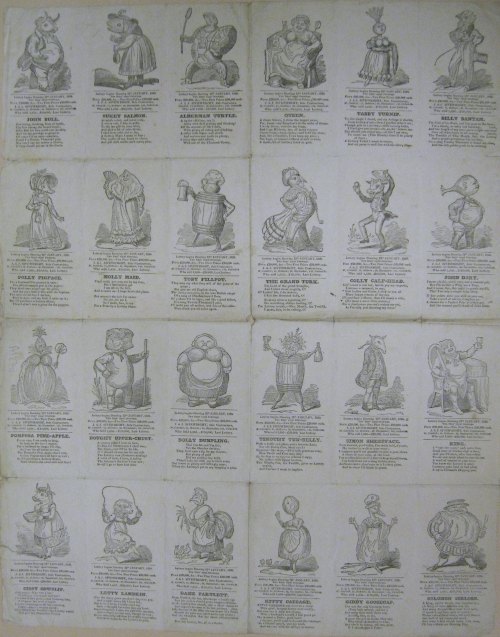Tonight is Twelfth Night, with the conclusion of the twelve days of Christmas (and coming of the Epiphany celebration) on tomorrow, 6 January. In England, Twelfth Night is a time of celebration with rich food and drink; traditionally, and especially in the Tudor era, it was also a festival of fantasy and role-reversal presided over by a Lord of Misrule. Shakespeare’s Twelfth Night was written as a fitting performance for the night.
By the nineteenth century, these associations were inspiring many commercial endeavors as well. A recently acquired sheet of advertisements for a lottery to be held in January 1820 features a menagerie of 24 Twelfth Night characters, mostly anthropomorphic edibles, from “Tabby Turnip” to “Solomon Sirloin.”

These advertisements, known as “puffs,” were made to be cut apart and handed out on the street to encourage the  purchase of lottery tickets. The characters were engraved by George Cruikshank, and this sheet is a rare, early example of his work, before he became famous as a caricaturist and illustrator of the works of Charles Dickens and others.
purchase of lottery tickets. The characters were engraved by George Cruikshank, and this sheet is a rare, early example of his work, before he became famous as a caricaturist and illustrator of the works of Charles Dickens and others.
Twelfth Night, with its sudden elevation of commoner to (mock) royalty, was a logical association to cultivate for a lottery. The eight-line poems beneath each character all promote the lottery. For instance, the poem for Timothy Tun-Belly reads:
With a bottle and glass, and a favorite Lass,
For old Daddy Care, what care I?
Supporters like mine — fill’d with generous wine,
Blue Devils and Care may defy.
By the drop in my eye, — a scheme I espy;
My cellars with liquor to store,
This Month, Sirs, the Twelfth, gives us Lottery wealth,
And Fortune I mean to implore.


